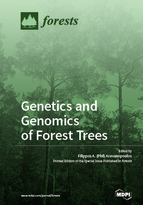Genetics and Genomics of Forest Trees
A special issue of Forests (ISSN 1999-4907). This special issue belongs to the section "Forest Ecophysiology and Biology".
Deadline for manuscript submissions: closed (28 February 2018) | Viewed by 97298
Special Issue Editor
Interests: forest genetics; conservation of genetic resources-genetic monitoring; population genetics; epigenetics-epigenomics; molecular breeding-QTL mapping-MAS; coevolution; fluctuating asymmetry & allometry
Special Issues, Collections and Topics in MDPI journals
Special Issue Information
Dear Colleagues,
Forest tree genetics and genomics are advancing at an accelerated rate, thanks to recent developments in high-throughput, next-generation sequencing capabilities and novel biostatistical tools. Population and landscape genetics and genomics have seen the rise of new approaches implemented in large scale studies that employ the use of genome-wide sampling. Such studies have started to discern the dynamics of neutral and adaptive variation in nature and the processes that underlie spatially explicit patterns of genetic and genomic variation in nature. The continuous development of genetic maps in forest trees and the expansion of QTL and association mapping approaches contribute to unravel the genotype-phenotype relationship and to lead to marker assisted and genome-wide selection. However, major challenges lie ahead. Recent literature suggests that species demography and genetic diversity have been affected both by climatic oscillations and anthropogenically induced stresses in a way that future adaptation may be questionable. Moreover, the pace of contemporary environmental change put a great challenge on forest tree populations and their ability to adapt taking into account their life history characteristics. Several questions emerge that include, but are not limited to, the interpretation of forest tree genome surveillance and their structural/functional properties, the adaptive and neutral processes that have shaped forest tree genomes, the analysis of phenotypic traits relevant to adaptation (especially adaptation under contemporary climate change), the link epigenetics/epigenomics to phenotype and genotype, and the use of genetics/genomics as well as genetic monitoring to advance conservation priorities. We encourage manuscript submission to this Special Issue from all relevant fields, both regarding experimental studies and modelling approaches, in order to promote knowledge in the areas of genetics and genomics of forest trees including the management and conservation of forest genetic resources.
Prof. Dr. Filippos A. (Phil) Aravanopoulos
Guest Editor
Manuscript Submission Information
Manuscripts should be submitted online at www.mdpi.com by registering and logging in to this website. Once you are registered, click here to go to the submission form. Manuscripts can be submitted until the deadline. All submissions that pass pre-check are peer-reviewed. Accepted papers will be published continuously in the journal (as soon as accepted) and will be listed together on the special issue website. Research articles, review articles as well as short communications are invited. For planned papers, a title and short abstract (about 100 words) can be sent to the Editorial Office for announcement on this website.
Submitted manuscripts should not have been published previously, nor be under consideration for publication elsewhere (except conference proceedings papers). All manuscripts are thoroughly refereed through a single-blind peer-review process. A guide for authors and other relevant information for submission of manuscripts is available on the Instructions for Authors page. Forests is an international peer-reviewed open access monthly journal published by MDPI.
Please visit the Instructions for Authors page before submitting a manuscript. The Article Processing Charge (APC) for publication in this open access journal is 2600 CHF (Swiss Francs). Submitted papers should be well formatted and use good English. Authors may use MDPI's English editing service prior to publication or during author revisions.
Keywords
Population/Landscape Genetics/Genomics
Conservation Genetics/Genomics
Functional Genomics
Epigenetics/Epigenomics
Adaptation
QTL/Association Mapping
Molecular Evolution
Proteomics
Phylogeography
Management of Forest Genetic Resources






